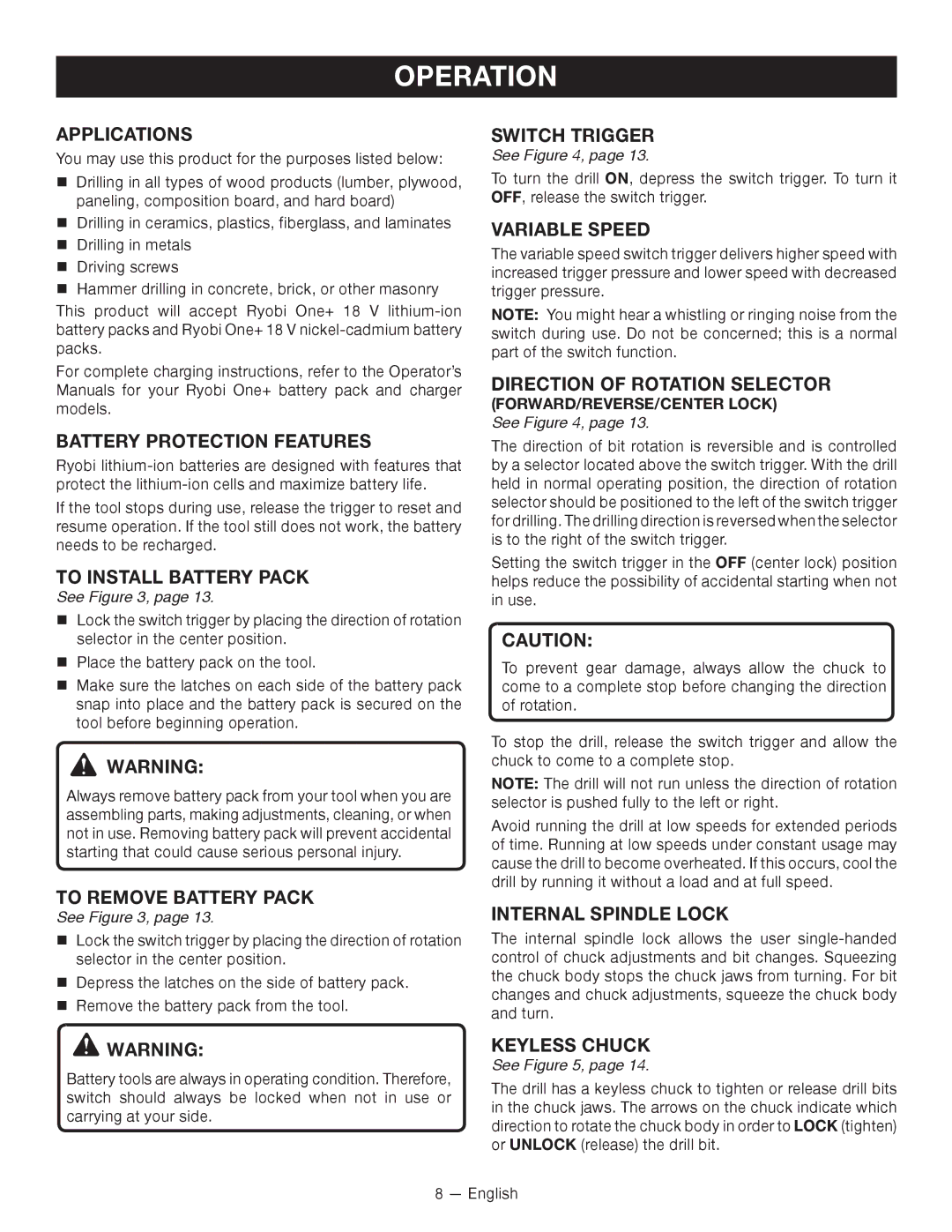
OPERATION
APPLICATIONS
You may use this product for the purposes listed below:
Drilling in all types of wood products (lumber, plywood, paneling, composition board, and hard board)
Drilling in ceramics, plastics, fiberglass, and laminates
Drilling in metals
Driving screws
Hammer drilling in concrete, brick, or other masonry
This product will accept Ryobi One+ 18 V
For complete charging instructions, refer to the Operator’s Manuals for your Ryobi One+ battery pack and charger models.
BATTERY PROTECTION FEATURES
Ryobi
If the tool stops during use, release the trigger to reset and resume operation. If the tool still does not work, the battery needs to be recharged.
TO INSTALL BATTERY PACK
See Figure 3, page 13.
Lock the switch trigger by placing the direction of rotation selector in the center position.
Place the battery pack on the tool.
Make sure the latches on each side of the battery pack snap into place and the battery pack is secured on the tool before beginning operation.
WARNING:
Always remove battery pack from your tool when you are assembling parts, making adjustments, cleaning, or when not in use. Removing battery pack will prevent accidental starting that could cause serious personal injury.
TO REMOVE BATTERY PACK
See Figure 3, page 13.
Lock the switch trigger by placing the direction of rotation selector in the center position.
Depress the latches on the side of battery pack.
Remove the battery pack from the tool.
![]() WARNING:
WARNING:
Battery tools are always in operating condition. Therefore, switch should always be locked when not in use or carrying at your side.
SWITCH TRIGGER
See Figure 4, page 13.
To turn the drill ON, depress the switch trigger. To turn it OFF, release the switch trigger.
VARIABLE SPEED
The variable speed switch trigger delivers higher speed with increased trigger pressure and lower speed with decreased trigger pressure.
Note: You might hear a whistling or ringing noise from the switch during use. Do not be concerned; this is a normal part of the switch function.
DIRECTION OF ROTATION SELECTOR
(FORWARD/REVERSE/CENTER LOCK) See Figure 4, page 13.
The direction of bit rotation is reversible and is controlled by a selector located above the switch trigger. With the drill held in normal operating position, the direction of rotation selector should be positioned to the left of the switch trigger for drilling. The drilling direction is reversed when the selector is to the right of the switch trigger.
Setting the switch trigger in the OFF (center lock) position helps reduce the possibility of accidental starting when not in use.
CAUTION:
To prevent gear damage, always allow the chuck to come to a complete stop before changing the direction of rotation.
To stop the drill, release the switch trigger and allow the chuck to come to a complete stop.
NOTE: The drill will not run unless the direction of rotation selector is pushed fully to the left or right.
Avoid running the drill at low speeds for extended periods of time. Running at low speeds under constant usage may cause the drill to become overheated. If this occurs, cool the drill by running it without a load and at full speed.
internal spindle lock
The internal spindle lock allows the user
KEYLESS CHUCK
See Figure 5, page 14.
The drill has a keyless chuck to tighten or release drill bits in the chuck jaws. The arrows on the chuck indicate which direction to rotate the chuck body in order to LOCK (tighten) or UNLOCK (release) the drill bit.
8 — English
